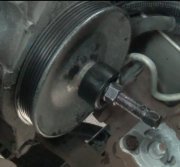There's two things that can cause that and they can be hard to tell apart. The easiest to see is simply an off-center steering wheel. Imagine if the car was in perfect alignment and went straight down the road when you took your hands off the steering wheel. Now you unbolt the steering wheel, remove it, turn it 1/4 turn to the right, and put it back on. The wheel alignment hasn't changed so the car still goes straight. All that is wrong is an off-center steering wheel. However, in this sad example, we know the cause, ... We messed with it. For this to happen under normal conditions the direction the two wheels are steering would have to be misadjusted or something shifted, (or got bent). Too many people think the car has a pull now because it will steer to the left if you PUT the steering wheel centered and hold it there. That is not a pull. That is simply an off-center steering wheel.
A pull occurs when the car steers to one side when you let go of the steering wheel. The steering wheel may or may not be straight. It's position is totally independent of what happens when you let go of it. Where things get confusing is when you have a pull, lets say to the right, and you have to counteract that by holding the steering wheel to the left. Of course the steering wheel is off-center now, but possibly not because of a misadjustment. Once the cause of the pull is corrected and you don't have to counteract it, the steering wheel might be centered again. When a customer says their steering wheel suddenly became off-center, the first thought is that's in response to a pull they didn't notice. Something happening to cause a pull is a lot more common than something magically changing adjustment to make the steering wheel off-center.
Now we have to add the variable of not knowing what happened to your car. If a wheel hit a curb, it is easy for a tie rod to get bent. That will change the direction one wheel is steering, and you have to counteract that so BOTH front wheels are off by an equal amount to keep the car going straight. "Toe" is the adjustment that will change on one wheel, and "total toe" is the critical adjustment that will be off, and it affects both wheels. Assuming all other alignment angles are correct, when total toe is wrong, regardless if toe is wrong on one or both wheels, the resulting tire wear will affect both tires equally. You will see a choppy pattern across the tread. Of the three things alignment specialists look at to determine where to start, reading the tire wear is the only one that has to occur over time, and they look at that when they start the alignment. The pulls and steering wheel position can be observed right now on a test drive.
You implied there was some but less of a pull before, and that suggests an alignment problem. Also, given the age of the car, sagged springs is most likely going to be part of the problem. Ride height is critical for proper braking, handling, comfort, AND tire wear. Even when the numbers appear to be correct on the alignment computer, if ride height is low, the suspension geometry will be wrong and the spindles will go through the wrong arcs as the car goes up and down over bumps. On cars and trucks with easily-adjustable torsion bar springs, it is common to bring a vehicle with miserable alignment numbers into perfect alignment just by adjusting the torsion bars up.
The problem with cars with coil springs is you often have to disassemble the adjustment points to replace the springs so you still have to do the alignment. Before we get to that point, since the pull existed before, we also have to consider a tire pull. That commonly occurs when there is no other underlying defect. The two tires just have different characteristics and react differently to the road surface. This is even more true when someone has mismatched tires. Start by switching the two front tires side-to-side. If the car pulls the other way now, it's a tire pull. About ten percent of the time the car will go straight. In that case, just leave the tires that way. Sometimes it can still pull the same way, and still be a tire pull, so that can be misleading. To figure out which one is responsible, switch the two left tires, then drive the car to see if it changed. If it didn't, switch the two right tires.
Regardless what you find, I would still have the alignment checked. The specialist at a tire and alignment shop will start with an inspection of the steering and suspension components, then he will look for verification of his findings in the tire wear patterns. Be sure to tell him if you switched the tires, otherwise he is going to be looking for the cause tire wear on the wrong corners of the car. He will also expect to see out-of-spec alignment numbers that agree with the tire wear he found. If the numbers and the tire wear don't agree, he is going to spend more time trying to determine the cause of that wear.
Monday, January 28th, 2013 AT 10:00 AM


